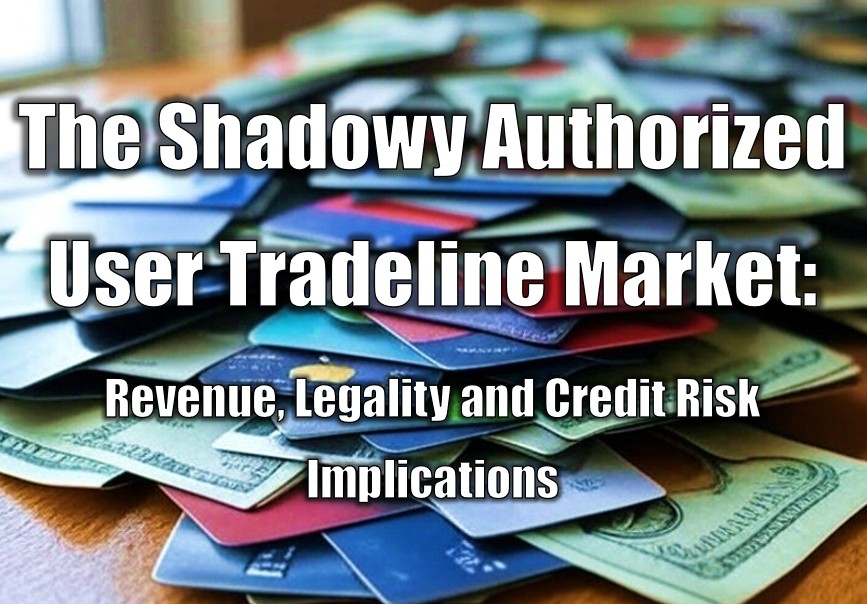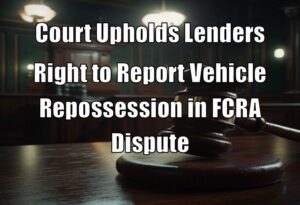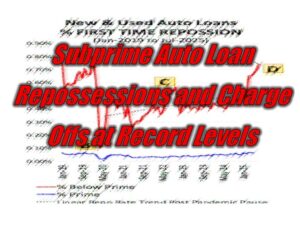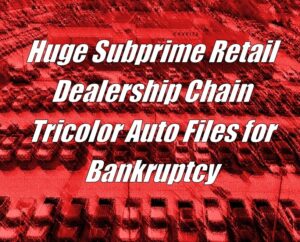An Estimated $200–$400 Million Market
Lurking in almost every loan portfolio are credit files littered with paid for tradelines. Authorized User (AU) credit card lines can quickly turn subprime borrowers into prime borrowers, all available online for a fee. Legal as it is, these loans are neither priced to accommodate the risk, they can be ticking delinquency time bombs.
Just Google “Tradelines For Sale” and you will see just how rampant and large the sale of Authorized User (AU) credit card lines. This credit building tactic has been used for years by fraudsters and credit repair companies. Unfortunately, it is nowhere near going away.
Authorized user (AU) credit card tradelines operate in a legal gray area, offering a quick way for individuals to boost their credit scores while posing significant challenges for lenders. This article explores the revenue generated by this market, its uncertain legal status, the potential for card issuers to revoke accounts, the FICO score increases it creates, and how these inflated scores mask actual risks to loan portfolios.
The Authorized User Tradeline Market
Authorized user tradelines involve adding an individual to an existing credit card account with a strong payment history, typically for a fee, allowing the authorized user to benefit from the account’s positive credit reporting without using the card. The primary account holder or a broker sells this access, capitalizing on the credit score boost it provides to buyers.
Revenue Estimation
Estimating the revenue of the AU tradeline market is difficult due to its fragmented and opaque nature, as no centralized data tracks these transactions. However, a reasonable estimate can be derived:
- Market Scope: Approximately 19% of U.S. consumers (50 million people) have at least one AU tradeline on their credit report, per a 2024 CFPB report. Assuming 1–2% of these individuals (500,000–1,000,000) buy tradelines annually through online platforms like Tradeline Supply or Superior Tradelines.
- Pricing: Tradelines typically cost $300–$1,500, with premium tradelines (high credit limits, long histories) reaching $2,000 or more, based on pricing from platforms like Tradeline Supply. Assuming an average price of $800 per tradeline, the market generates:
- Lower bound: 500,000 buyers × $800 = $400 million
- Upper bound: 1,000,000 buyers × $800 = $800 million
- Adjustments: Accounting for private transactions and issuer crackdowns, online sales likely account for 50% of the market, yielding an estimated $200 million to $400 million in annual revenue.
This revenue is split among brokers (who take 20–50% commissions), primary cardholders, and marketing platforms, with growth driven by online accessibility despite regulatory scrutiny.
Legal Gray Area
The sale of AU tradelines exists in a legal gray area in the U.S. No federal statute explicitly prohibits adding someone as an authorized user for a fee, provided no fraudulent misrepresentation occurs (e.g., lying about the buyer’s relationship to the cardholder). However, the practice raises concerns:
- Issuer Terms of Service: Major card issuers like Chase and American Express have terms that discourage “gaming” the credit system. Selling tradelines may violate these agreements, leading to account reviews or closures.
- Regulatory Scrutiny: The Federal Trade Commission (FTC) and Consumer Financial Protection Bureau (CFPB) monitor tradeline sales for deceptive marketing. If buyers are misled about benefits or risks (e.g., temporary score boosts), sellers could face penalties under consumer protection laws, as noted in CFPB guidelines.
- State Laws: Some states may view tradeline sales as deceptive if not transparently disclosed, though no major court cases have definitively ruled the practice illegal. The intent behind the transaction matters—falsifying information could cross into fraud, violating federal or state laws.
Posts on X highlight this ambiguity, with some users calling tradelines a “legal loophole” and others warning of scams or account closures, reflecting the practice’s uncertain status.
Card Revocation Risks
Lenders and card issuers can revoke or close credit card accounts if they detect AU tradeline sales. Major issuers monitor for suspicious activity, such as adding multiple unrelated authorized users or patterns suggesting commercial transactions. For example:
- Issuer Policies: Chase and American Express explicitly state in their terms that accounts may be closed for misuse, including adding authorized users for profit. A 2023 Reddit thread noted cases where accounts were flagged after frequent AU additions.
- Consequences: Account closure can harm the primary cardholder’s credit (e.g., increased utilization ratios) and remove the tradeline from the buyer’s credit report, negating the score boost. This also exposes lenders to risk if they’ve relied on the buyer’s inflated score.
- Detection Methods: Issuers use algorithms to flag unusual AU activity, such as rapid additions/removals or users with no apparent relationship to the cardholder. Some issuers limit the number of AUs (e.g., 2–10 per account) to curb abuse.
This risk discourages some sellers but hasn’t eliminated the market, as enforcement varies across issuers.
Impact on Credit Risk for Lenders
The AU tradeline market introduces significant credit risk for lenders by artificially inflating credit scores, masking borrowers’ true creditworthiness. Lenders rely on FICO scores to assess risk and determine loan eligibility, interest rates, and terms. Tradelines create the following issues:
- Distorted Credit Profiles: AU tradelines add positive credit history (e.g., low utilization, on-time payments) to a buyer’s credit report without reflecting their actual financial behavior, making high-risk borrowers appear low-risk.
- Temporary Score Boosts: The credit score improvement often fades within 1–3 months if the tradeline is removed or the account is closed, increasing default risk for lenders who approved loans based on inflated scores.
- Fraud and Misrepresentation: Deceptive tradeline practices (e.g., misrepresenting relationships) can trigger account closures, potentially harming the buyer’s credit and increasing lender exposure to defaults.
- Portfolio-Wide Risk: Large-scale tradeline use can inflate credit quality metrics across loan portfolios, leading to undercapitalization for potential losses, especially in markets like mortgages or auto loans.
FICO Score Increases from AU Tradelines
The FICO score impact of AU tradelines varies based on the buyer’s credit profile, the tradeline’s quality, and the number purchased:
- Typical Score Increases: A single high-quality tradeline (e.g., $20,000 limit, 5+ years history) can boost a FICO score by 20–100 points, particularly for those with thin or poor credit files. For example, a score of 580 might rise to 650–680, moving a borrower from subprime to prime status, per FICO’s scoring model.
- Diminishing Returns: A second tradeline might add 10–30 points, with minimal impact beyond two tradelines unless the credit file is very thin.
- Key Factors:
- Credit Utilization: Tradelines with low utilization (e.g., 10% of a $50,000 limit) lower the buyer’s overall utilization, a major FICO factor.
- Account Age: Older accounts (10+ years) enhance the “length of credit history” component.
- Payment History: Perfect payment records improve the “payment history” factor (35% of FICO).
A 2023 Quora post noted that $30,000 in tradelines could boost a thin-file score by 50–150 points, though results vary.
Masking Actual Risk to Loan Portfolios
Artificially inflated FICO scores from AU tradelines create a disconnect between perceived and actual risk, endangering loan portfolios:
- Mispriced Loans: Lenders may offer lower rates or larger loans to borrowers with inflated scores. A borrower with a true FICO of 600 (subprime) might appear as 700 (prime), securing a mortgage they’re less likely to repay.
- Increased Delinquency Rates: If tradelines are removed post-loan approval (e.g., due to issuer revocation), the borrower’s score may drop, reflecting their true financial instability. This increases missed payment risks, similar to subprime defaults in 2008.
- Portfolio Contagion: Widespread tradeline use can inflate portfolio-wide credit quality metrics, leading to undercapitalization. The OCC’s *Comptroller’s Handbook* notes that higher-risk borrowers increase revenue but also default risk.
- Regulatory and Reputational Risk: Lenders unaware of tradeline use may face scrutiny for inadequate risk assessment, especially if defaults rise. The CFPB and FTC’s focus on deceptive tradeline marketing could indirectly implicate lenders.
Quantifying the Risk
Consider a hypothetical portfolio:
- A lender approves $1 billion in mortgages, with 5% of borrowers (~$50 million in loans) using tradelines to inflate scores from 600 to 700.
- If 20% of these borrowers default (vs. 5% for true prime borrowers), the lender faces $10 million in losses (20% of $50 million) versus $2.5 million expected, potentially scaling to hundreds of millions across portfolios.
Conclusion
The AU tradeline market, generating an estimated $200–400 million annually in the U.S., operates in a legal gray area, exploiting credit reporting gaps to deliver FICO score boosts of 20–150 points. While not explicitly illegal, it risks account revocation by issuers like Chase or AmEx, harming both cardholders and buyers.
For lenders, tradelines mask true credit risk, leading to mispriced loans, higher delinquency rates, and potential portfolio losses in the tens of millions. Enhanced risk models, such as scrutinizing AU tradeline patterns or using alternative data, are crucial to mitigate these risks. As regulatory scrutiny grows, the tradeline market’s future remains uncertain.
Kevin Armstrong
Publisher
The Shadowy Authorized User Tradeline Market: Revenue, Legality and Credit Risk Implications – The Shadowy Authorized User Tradeline Market: Revenue, Legality and Credit Risk Implications – The Shadowy Authorized User Tradeline Market: Revenue, Legality and Credit Risk Implications – The Shadowy Authorized User Tradeline Market: Revenue, Legality and Credit Risk Implications – The Shadowy Authorized User Tradeline Market: Revenue, Legality and Credit Risk Implications – The Shadowy Authorized User Tradeline Market: Revenue, Legality and Credit Risk Implications
The Shadowy Authorized User Tradeline Market: Revenue, Legality and Credit Risk Implications – Credit Union Collections – Credit Union Collectors – Lending – Fraud















Facebook Comments